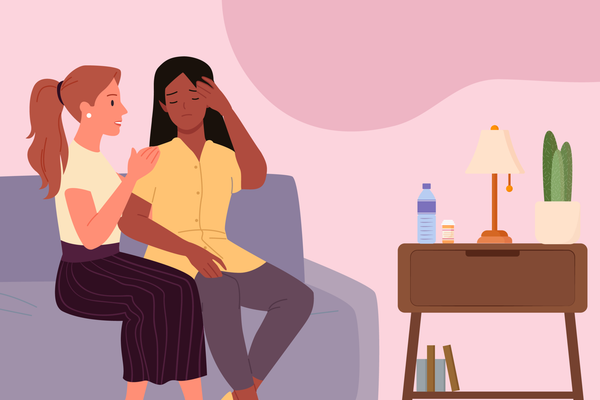By Natalie Miller Moore
Feeling a migraine coming on? It's not a good feeling. And not only because you're anticipating the symptoms, but also because migraines can completely upend your schedule. It's hard to do anything while you're having a migraine, but understanding what's happening to you may help.
How do I know if I am having a migraine?
Migraines are a recurring type of headache, so it's not just "the worst headache you've ever had"—it's a repeated event with some specific features. Migraines can include feelings of throbbing or pulsing, or pain concentrated on one side of your head. Some migraines include symptoms like nausea and weakness, or sensitivity to lightness or sound. Auras, which are sensations of flashing light, bright lights, zigzag lines or changes in vision, can happen before or during a migraine.
Do migraines run in the family?
Women are three times as likely to get migraines as men, and most people have family members with migraines or other medical conditions affecting the brain. Talk to your mother, sisters and aunts to see if they've had migraines, and what age they began having them. You might even get some good advice!
If I go see my health care provider, what's the process for diagnosing migraines?
Your health care provider will ask you about your medical history and your symptoms, along with a physical and neurological exam. In preparation, it's a good idea to talk to your relatives about any conditions they've dealt with or have been diagnosed with. To rule out other medical conditions that have similar symptoms, you may need to have a blood test, or even an MRI or a CT scan, to investigate any headache-causing issues in your brain.
Are there different types of migraines?
There are many different kinds of migraines, and it may be helpful for you to note your specific symptoms to share with your neurologist.
- How frequently are you having a migraine?
- What are the symptoms associated with them? Are they consistent?
- Is there a common feature, such as type of the month coinciding with your menstrual cycle? Or, right after you eat a certain food?
- Is the type of pain you are experiencing consistent? Where is it located?
There many types, and you may need to refer to your migraine journal for specifics to help you narrow it down to your type.
What are the treatment options for migraines?
There are a number of treatment options, including preventive medications, taken regularly, and pain-relieving medications, taken once the migraine attack starts. Innovations in treating migraines are still moving forward. You'll need to talk to your health care provider about your type of migraine and discuss the pros and cons of each treatment option.
One of the first options many women try are over-the-counter pain relievers, but since migraines are not your typical headache, triptans are another option. Triptans work by blocking pain pathways in the brain, and they can relieve many symptoms of migraine, but they aren't safe if you are at risk for a stroke or heart attack (check with your health care provider for more information on your personal risks.) Other options include dihydroergotamines (usually a nasal spray or injection), opioids or anti-nausea drugs—each with risks and benefits.
What are some ways to identify migraine triggers?
Keeping a migraine journal can be an important part of tracking your migraines – because they are individual to you. Noting when they start, what happened right before you started feeling symptoms and what the environmental conditions are can help you pinpoint your triggers.
For example, if you find that changes in the weather or hormonal fluctuations seem to be the same prior to a migraine, you might be prepared to take your medication with you wherever you go.
- Lifestyle changes might help, including managing your stress, having a consistent sleep routine and exercising regularly. Reducing alcohol consumption, particularly headache-inducing red wines, may help.
- Hormone triggers may be addressed with hormonal birth control to prevent fluctuations throughout the month. Some women find that a long-acting reversible contraceptive like an IUD helps them maintain a steady hormonal balance in their body.
- You might also find that keeping track of your diet helps you identify a triggering food, such as processed food, foods with caffeine or nitrates.
Is there a way to cure migraines?
Unfortunately, there is no cure, but there is some good news. Migraines can be stopped and they can be prevented, to a degree. You can investigate which kind of drugs work for you, and knowing the signs can help you get relief sooner.
Because migraines change as you age, you may need to continually re-evaluate how you are managing and treating them. The impact on your life can be managed if you are vigilant and pay attention to your daily health.
- Healing Environments Need to Recognize Migraine Triggers ›
- Most People Who Experience Migraine Are Women: Here’s What You Need to Know ›
- When It's More Than Just a Bad Headache ›
- How to Know If You’re Experiencing Migraine ›
- Can Migraine Attacks Be Triggered? - HealthyWomen ›
- A New Device Can Help Healthcare Providers Treat Migraine Attacks - HealthyWomen ›
- What's Your Headache Type? - HealthyWomen ›
- What To Do About Migraine at Work - HealthyWomen ›
- 8 Types of Migraines - HealthyWomen ›
- 8 tipos de migrañas - HealthyWomen ›
- Lo que debes hacer acerca de migrañas en el trabajo - HealthyWomen ›
- For Years, I Didn’t Know I Had Menstrual Migraines - HealthyWomen ›
- Pasé años sin saber que tenía migrañas menstruales - HealthyWomen ›
- Migraine Toolkit - HealthyWomen ›
- Guía práctica para migrañas - HealthyWomen ›






